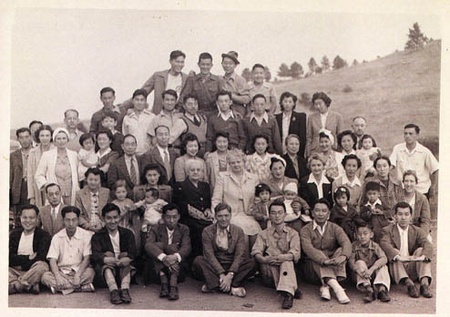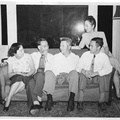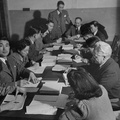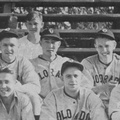We have heard the meaning and effect of the vocabulary used by the majority aimed at the minority Japanese and Japanese Americans while the United States was at war with the Empire of Japan. However, there is quite another, formerly secret and almost unknown, story of the Japanese American sensei at the US Navy Japanese Language School at the University of Colorado. These sensei, through the teaching of Japanese, made a large contribution to both the war effort and the peace through their teaching of the Japanese language and the actions of their students. Scholars have been surprised to discover the influence these Navy and Marine Japanese language officers had in Naval and Marine intelligence, radio interception, code decryption, document translation, and prisoner of war interrogation during the war. But other scholars in East Asian studies have been equally astounded to discover the influence these former language officers wielded in US Japanese and Asian studies between 1950 and 1990. Even less well known, but also amazing, is the influence that other former Japanese language officers had in the various US intelligence agencies and in American diplomacy during this same period. A new scholarship is slowly developing that is beginning to reveal the importance of this small wartime Navy school and its 1650 attendees. But if the graduates contributed so greatly to the American academic, intelligence, and diplomatic understanding of Japan and Asia, were not the most important contributors those who taught them and turned their minds and understanding to matters Japanese? Are not the bridge-builders of that intellectual arch across the Pacific the sensei of the US Navy Japanese Language School? I believe an argument can be made for this contention.
Actually established in Japan, the US Navy, Army and the State Department Japanese Language Schools educated small numbers of Foreign Service, Military, and Naval Academy officers after the stunning triumph of the Japanese Empire over the Russian Empire in 1905. For thirty years, the Navy assigned individual Naval Academy graduates to a 3 year course in Tokyo, for which their chief sensei, Naoe Naganuma, created a set of instructional texts that immersed the students in Japanese culture and history, while teaching the language. By 1940, US/Japanese diplomatic tensions both required the transfer of the school to the US, and suggested changes in student numbers and length of training. The Navy had to find a new school location, while enlarging school enrollment and shortening the program’s length from 3 years to 14 months. These changes were necessary to provide the numbers of language officers necessary for wartime missions as soon as possible. American academics in Japanese language were not convinced that they could teach Japanese to students in 14 months. The Navy Japanese Language School organizer, Commander Albert E. Hindmarsh, knowing the difference between education and training, dismissed the use of academics to train naval students in Japanese, preferring to recruit bilingual Japanese American professionals for the new Naganuma program. After an experiment at both Harvard University and the University of California Berkeley in 1940-41 showed that Berkeley would best follow the Navy model, the Program recruited a number of Japanese American sensei to teach the several dozen, largely Japan and China-raised American students.
However, after the Japanese attack on Pearl Harbor and the subsequent Executive Order 9066, the US Navy Japanese Language School had to move east, so that its sensei would not be interned, halting instruction. The University of Colorado proved the perfect location, in one of the few Western states and universities that did not bar Japanese residence or attendance. Governor Robert Carr had “welcomed” Japanese to Colorado, University President Robert Stearns was looking for Navy Schools to offset both the draft and the enlistment drain from university enrollment. So the Navy school, students and sensei moved to the University of Colorado in June of 1942. The Director of the school was Florence Walne, a Berkeley faculty member, but the ranking instructors (sensei) were Susumu Nakamura and Henry Tatsumi, a Japanese language professor from the University of Washington. By October 1942, it was obvious to the Navy and Commander Hindmarsh that the number of Japanese American instructors had to increase to accommodate rising student enrollment. The Japanese American sensei were encouraged to recruit bilingual Japanese American professionals (doctors, lawyers, teachers) of their acquaintance from the Transit and Internment Camps. Hindmarsh had general advertisements placed in camp newspapers. Language school instructor recruits and their families often faced the hostility of their fellow internees for their choice to serve the country that had interned them. The vast majority of sensei between 1942 and 1946 would be Japanese American, 164 of the total 177 recruited to teach at the school.

Sansei of US Navy Japanese/Oriental Language School and their family at Chautauqua Park in Boulder. Florence Walne, the director is in white. (Glen Slaughter Collection, Box 1, folder 6, number 6, Archives, University of Colorado at Boulder Libraries.)
But once in Boulder and at the University of Colorado, a remarkable synergy took place. One can easily view this transformation from the stories that have been submitted to seven years of our USN Japanese/Oriental Language School Archival Project’s newsletter, The Interpreter. The Japanese American sensei were able to use the Naganuma texts along with others of their own devising, like Ensho Ashikaga’s Kaigun Tokuhon, the Sosho text, and a number of Japanese language dictionaries to instill a novel and unexpected admiration of Japan, its people and its culture, in young American naval students immediately following Pearl Harbor. While the wartime American culture trumpeted anti-Japanese rhetoric and flashed racist stereotypes, these young students, themselves former faculty members, graduate students, and language academics, found themselves beguiled by their sensei and texts in the most intellectually rigorous of Navy training programs. Not only did the students grow to admire the Japanese culture and society they viewed through Kanji and folk tales, but they also held their sensei in very high esteem. Far from feeling they were being taught by an “enemy” they trusted and venerated their sensei. It was an appreciation that grew to be mutual, as the sensei began to respect the dogged determination and skill of their students. The sensei also invited their students to parties and dinners at their homes, where their children would sing songs to the students and the sensei family would share their small food ration of Japanese cuisine with them. In this way, students were able to view the application of what they were learning into actual traditional Japanese family life and social behavior. Students and sensei exchanged presents, art, and a lifelong high regard. One sensei, speaking for many, told his children that some of the best times in his life were spent teaching Japanese to young US Naval students in Boulder, Colorado.
The Japanese American sensei of the US Navy Japanese Language School used Japanese words/Kanji to immerse more than 1,200 Caucasian men and women in the language and culture of Japan. The graduates then went into the Navy and Marines and intercepted, decrypted, translated and interpreted Japanese radio traffic, translated captured Japanese documents, interrogated Japanese POWs, negotiated the surrender of bypassed Japanese units, arranged the repatriation of prisoners, and assisted in the administration during the Occupation of Japan. Language officers created clinics for wounded Japanese prisoners in the heat of battle. They created a school for Japanese children, in Japanese, taught by Japanese teachers on Tinian. Language officers translated leaflets into Japanese and dropped leaflets and used PA systems to encourage surrender and dissuade Japanese soldiers and civilians from committing suicide. Language Officers created warning leaflets that were dropped on Japanese cities requesting evacuation prior to bombing raids. One language officer was decorated for saving an entire captured Japanese military unit from starvation. The behavior of Navy and Marine Japanese language officers toward Japanese prisoners and civilians has been described as sympathetic, sensitive, and through their knowledge of the culture and society, extremely effective. Former Japanese POWs kept up long friendships or spent lifetimes seeking out their former captors in order to offer thanks.
Not only did the sensei generate considerable effects during the Pacific War, Occupation and various national postwar occupations, the Language School and its sensei had an enormous and measurable personal effect on their students and their families. While it could be expected that the somewhere around 15% of the attendees of the school who had been born and raised in Japan or China would continue their interest in Asia, the vast majority of the attendees and graduates had their first immersion in the Japanese culture and language from the sensei of the US Navy Japanese Language School. Of this majority, more than two thirds of those who have contacted our project told us that the school and its sensei changed their lives. The claim is proven not only by the great numbers of graduates who later chose careers in Asian studies, far eastern intelligence and US diplomacy in Asia, but also by their subsequent missionary work, US/Japan reconciliation activities, as well as by lifelong cross racial friendships and interracial marriages with Japanese and those of subsequent generations in their families. To a great degree, these unknown Japanese American sensei may have been unintentional traffic signs who through their teachings directed sharp turns to the East in the lives of many of their Navy language students.
Walking Tour of US Navy Japanese Language School at the University of Colorado at Boulder, July 3, 2008
David M. Hays, archivist and Director of the US Navy Japanese/Oriental Language School Archival Project, along with Professor Emeritus, Donald Willis and Reverend Robert Bruns (both World War II JLS graduates) will lead a walking tour of the older portion of the University of Colorado at Boulder, featuring those buildings that were used for the US Navy Japanese Language School during World War II. The tour will have nine points of interest that will also feature stories and a Q&A. For more information, visit the Enduring Communities Web site.
* David Hays will be leading a walking tour of the former site of the US Navy Japanese Language School at the University of Colorado at the Enduring Communities National Conference on July 3-6, 2008 in Denver, CO. Enduring Communities is a project of the Japanese American National Museum.
(cc) DN site-wide licensing statement






